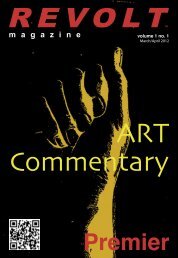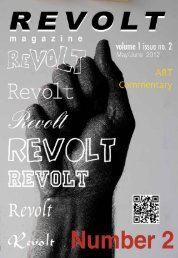Download PDF Version Revolt Magazine, Volume 1 Issue No.4
Download PDF Version Revolt Magazine, Volume 1 Issue No.4
Download PDF Version Revolt Magazine, Volume 1 Issue No.4
Create successful ePaper yourself
Turn your PDF publications into a flip-book with our unique Google optimized e-Paper software.
absurd and misogynistic claims leveled against her.<br />
But men are not the only culprits of perpetuating<br />
this type of discourse, Horyn goes on to quote a<br />
designer who, “observed, with some accuracy, ‘Her<br />
clothes are too tight.’” As though this criticism is<br />
not only of the utmost importance, but also a strike<br />
against her and an indictment of her character.<br />
Even though America has pushed Michelle Obama<br />
to embrace her role as its First Lady fashionista,<br />
she is not even permitted to find respite within this<br />
feminine stereotype. When she plays into the heavily<br />
gendered role she’s been dealt, the criticism is just<br />
as intense and focused as when she was viewed as<br />
her husband’s radical-thinking co-conspirator.<br />
The New Yorker on January 22, 2013 justified<br />
the lack of negative media attention surrounding<br />
Michelle Obama’s pricey clothing (which, in fact,<br />
there has been a substantial amount of critique on),<br />
by saying, “When her husband ran for President in<br />
2008, there were barely veiled insinuations about<br />
whether the role of First Lady was really right for<br />
her—whether she was too angry, or could really<br />
Photo courtesy of The White House.<br />
feel comfortable. (One suspects that a sense of the<br />
pressures on her may explain why she is not taken to<br />
task as much as she might be for the price of these<br />
clothes.)” So, in other words, in the face of massive<br />
amounts of criticism surrounding her aptitude to<br />
simply be married to the President of the United<br />
States, her luxurious fashion expenditures have<br />
been forgiven as an effort to fit in. Horyn’s 2012<br />
New York Times article suggested a very similar<br />
idea, saying, “It’s a funny thing: four years ago she<br />
denied conservatives the chance to vilify her as ‘an<br />
angry black woman’ by taking immense pleasure<br />
in traditional first lady pursuits, like fashion,<br />
entertaining and gardening.” In other words, the only<br />
safe place in politics for intelligent women to prove<br />
themselves as true role models and not be branded<br />
as angry, bitchy, or stubborn shrews, is to retreat<br />
into the shallow, vain realm of the traditionally<br />
feminine. These articles promote the idea that if a<br />
woman is opinionated, politicized or powerful she<br />
automatically, and unquestionably, is asking for<br />
criticism. Traits that are respected and encouraged<br />
in male political candidates, in women, become<br />
egregious trademarks of an overbearing personality<br />
that has overstepped its proper bounds and can only<br />
be tamed by relegating her authority and decision<br />
making into venal pursuits. Even the topics the First<br />
Lady endorses during her husband’s presidency<br />
are meant to be of the simplest, most ethically<br />
uncontroversial nature (although, there are a handful<br />
of First Ladies who have proved exceptions to this<br />
rule). Laura Bush, for example, promoted education,<br />
while Michelle promotes “Let’s Move,” a campaign<br />
devoted to ending childhood obesity in America and<br />
promoting healthy eating habits. However, even this<br />
meager, unquestionably positive health initiative<br />
(a step towards the demure femininity expected of<br />
Mrs. Obama), has not managed to escape the wrath<br />
of politicians and pundits claiming Mrs. Obama is<br />
trying to tell Americans how to raise and what to<br />
feed their children.<br />
Wisconsin Republican congressman Jim<br />
Sensenbrenner very publicly took the First Lady’s<br />
health initiative to task, when he was overheard<br />
at Washington’s Reagan National Airport loudly<br />
criticizing “Let’s Move,” saying, “She lectures us<br />
on eating right while she has a large posterior<br />
herself.” After causing a media sensation with<br />
his rude, insensitive, and plainly inappropriate<br />
remarks, Sensenbrenner (who is not exactly the<br />
paragon of health himself) promised to “send the<br />
first lady an apology.” It’s clear from his statement<br />
that Sensenbrenner’s problems lie not with the<br />
First Lady’s initiatives to promote healthy children,<br />
but rather with her body. This is a fundamentally<br />
misogynist issue many male Republicans seem<br />
to currently be struggling with: the belief that it is<br />
their right to objectify, comment upon and legislate<br />
the female body. The lack of backlash and public<br />
outrage against Sensenbrenner only encourages<br />
such invectives and makes it seem acceptable, even<br />
permissible, to discuss a First Lady’s posterior when<br />
describing her politics. Criticisms that were once<br />
considered taboo, particularly when discussing the<br />
first family, have suddenly been given a no-holds-bar<br />
policy under the Obama administration. It seems<br />
that white politicians and the media have made<br />
the collective decision that electing a black man<br />
into office has lifted a moratorium on the political<br />
incorrectness of full-blown, uncensored racism and<br />
sexism.<br />
Much like Sensenbrenner, in January 2012, a<br />
speaker of the Kansas House, Republican Mike<br />
O’Neal, had to apologize after forwarding an email<br />
around the House which referred to the First Lady<br />
as “Mrs. YoMama.” He claims that he forwarded<br />
the email on without reading it, simply enjoying the<br />
picture of Mrs. Obama side by side with the Grinch<br />
above the caption “Twins separated at birth?” In his<br />
mind, this seemed to excuse the racist slur found<br />
above. In a public statement, O’Neal said that he<br />
found the cartoon amusing because, “I’ve had bad<br />
hair days too.” An unacceptable response to even<br />
more unacceptable behavior. But it’s not just her<br />
physical appearance that has riled a conservative<br />
nation, but also the ease with which she’s accepted,<br />
even embraced, her role as a pop icon and a woman<br />
who wields substantial media power.<br />
The American media has turned Michelle Obama<br />
into a celebrity, a pop culture phenomenon and an<br />
arbiter of style. Yet, at every turn, as she accepts<br />
and utilizes her unique status and position to<br />
promote positive change, she is greeted with<br />
immense backlash, criticizing her for feeding into<br />
the Hollywood machine. When she was invited to<br />
pose for the cover of Vogue in 2008, her advisers<br />
were concerned that she might be seen as “a<br />
fashionista,” a status she assuredly already had<br />
and that has only grown throughout the duration of<br />
her husband’s presidency. To Michelle’s credit, she<br />
made the compelling argument in favor of posing<br />
for the cover, saying that, “there are young black<br />
women across this country, and I want them to see a<br />
black woman on the cover of Vogue.” In the end, the<br />
cover received little notoriety or criticism, unlike her<br />
2013 Oscar appearance where she announced, via<br />
satellite along with Jack Nicholson, the Oscar winner<br />
for Best Picture. The Washington Post claimed that<br />
“attendees and viewers were flabbergasted at the<br />
satellite image of the elegantly dressed, Obama.”<br />
Many accused her of indulging in the frivolities of<br />
stardom and the media criticized her for playing<br />
the role of the Hollywood starlet. An ironic jab at<br />
Michelle, considering these publications are a part<br />
of the same publicity machine that simultaneously<br />
encourage this exact type of celebrity tabloid<br />
coverage surrounding the First Lady, cataloging her<br />
outfits and purchases down to the smallest detail.<br />
The American people and media have cast Michelle<br />
Obama in the role of entertainer and then condemn<br />
her when she chooses to play along.<br />
America has created a no-win situation for the First<br />
Lady. Either she’s a political and intellectual radical<br />
and “angry black woman,” or she is a fashionista<br />
with a spending problem and an over-investment in<br />
frivolous, undignified pursuits. In the 2009 Economist<br />
piece by Wooldridge, he said, “I think if a first lady<br />
were purely decorative in the 21st century, it would<br />
actually look rather odd.” But isn’t that precisely the<br />
position the media is attempting to cast Michelle<br />
Obama in? The media, Obama’s fellow politicians,<br />
even the White House itself has attempted to paint<br />
her as this decorative, fashionable mouthpiece of<br />
“change.” Michelle, much like Hilary before her,<br />
is not the quiet, demure woman behind the man<br />
that is easily silenced or brushed aside. Both are<br />
smart, capable progressive women who seek to use<br />
their political positions as platforms to make real<br />
progress forward. When we limit our discussion of<br />
women in power to their physical appearance and<br />
choice in apparel and hairstyle, we strip them of<br />
their authority and try to re-appropriate them as flat,<br />
antiquated images of womanhood. We are in the<br />
midst of a struggle to redefine the spheres females<br />
are allowed to encompass and wield authority<br />
within, and news sources, by proliferating these<br />
REVOLT<br />
<strong>Magazine</strong> Number 4, 2013 16





